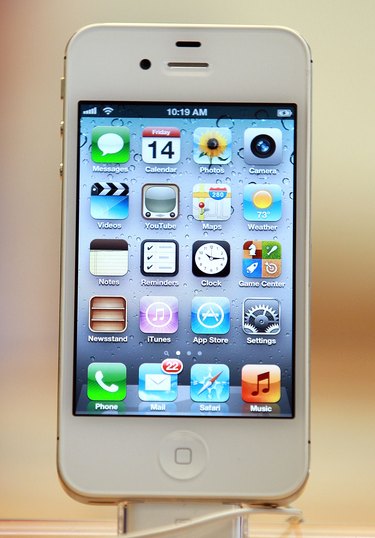
The iPhone relies almost entirely on a touch-sensitive screen, which allows users to navigate programs and issue commands with taps, swipes and pinches. When this screen malfunctions, using the iPhone can be difficult, if not impossible. Several issues can cause the screen to stop functioning properly, but this is primarily a problem of hardware, which cannot usually be fixed by a layman.
Debris
Video of the Day
The iPhone's touch screen works by sensing changes in electrical current from your fingertips. This is why a stylus won't work on a touch screen -- it doesn't conduct current. Oil and grime on the iPhone screen may prevent it from detecting your touch, so cleaning the screen with a moist microfiber cloth may return it to a functional state. Also, your fingers may be dirty, so washing your hands might help. If you use a protective shield, air bubbles or trapped debris may interfere with the screen's readings. Remove it to see if this is the problem.
Video of the Day
Restart or Reset
Minor glitches can interfere with the transmission of signals inside the iPhone. If this is the case, restarting the iPhone may ameliorate it. To turn off the iPhone, press the "Sleep/Wake" button on the top of the iPhone until the red slider appears; then swipe the button across the slider. If this does not affect the problem, resetting the iPhone is another option. Pressing and holding the "Sleep/Wake" and "Home" buttons until the Apple logo appears will reset the phone.
Restore
If the problem lies in any software malfunction, a restoration will fix it. This process wipes the iPhone clean and reinstalls the basic operating system. You can restore the iPhone by connecting it to the computer, opening iTunes, clicking the iPhone's name under Devices on the left side of the browser and clicking "Restore" in the center of the browser. While you can immediately re-sync any media stored in iTunes, you will lose your personal data and settings.
Hardware
Hardware damage is a common cause of the iPhone's touch screen malfunctioning. Getting the iPhone wet is a leading culprit because liquid can disrupt the transmission of electrical currents, and a cracked screen, which often results from dropping the phone, interrupts the careful network of wiring. Extreme temperatures may also damage the screen or the internal wiring. In these cases, the iPhone requires a specialist for repairs, as it likely needs replacement parts.